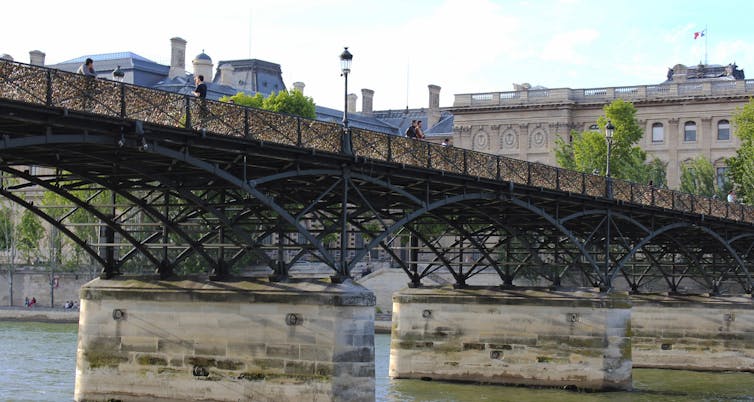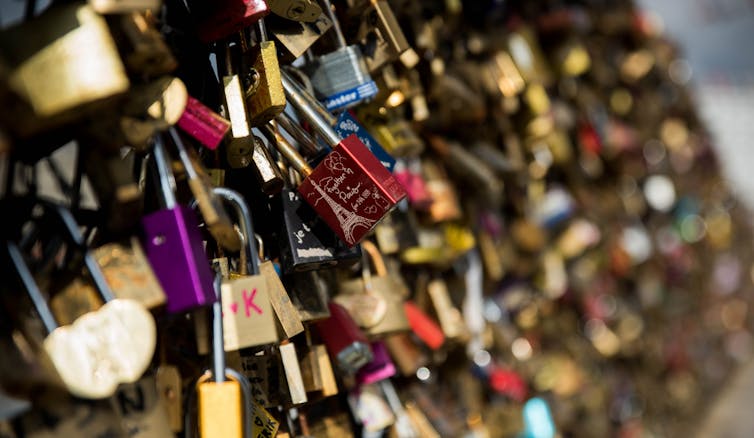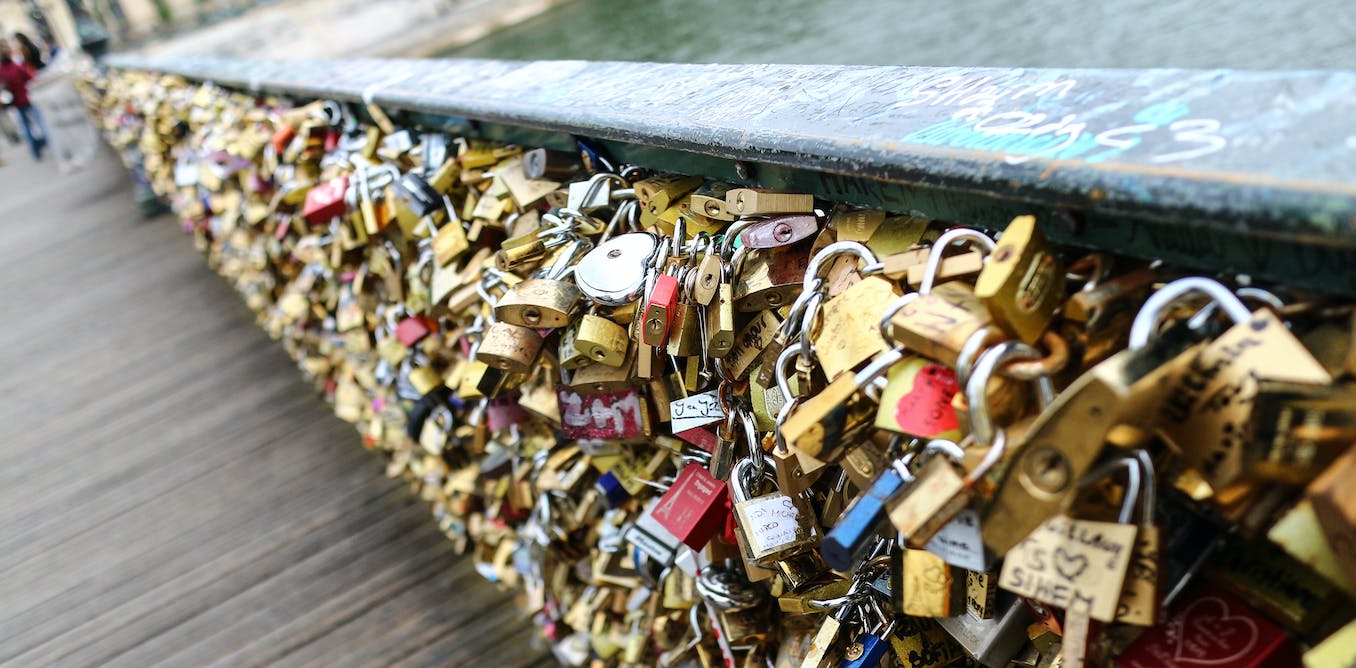The lock of love: how leaving padlocks became a modern-day romantic ritual
Cities as distant and varied as Moscow and Manchester, New York and Newport, Beijing and Blackpool all have one striking feature in common. Masses of padlocks, engraved with the names or initials of love-struck couples, bedeck notable landmarks such as bridges and fences – sometimes to the ire of local authorities.
The exact origins of the “love locking” practice are unknown, but it rapidly gained global momentum after emerging in Rome and Paris during the 2000s. The locks have become romantic tokens – universal symbols for the commitment, strength and constancy of a relationship.
Yet this symbol of unity has proven ironically polarising. Many authorities view the custom negatively, and collections of love locks have been removed from bridges following safety concerns. Such worries are not misplaced: in 2014, a railing on the Pont des Arts in Paris collapsed under the weight of its love locks.

Nik Boiv/Flickr, CC BY
The following year, the bolt-cutters were out in force, and over one million padlocks (weighing 45 tonnes), were removed from the bridge to prevent further damage. Similar responses have been seen worldwide, from Leeds to Melbourne.
Forbidden love
But in many cases it’s not concern about a bridge’s structural integrity that sees authorities reaching for the bolt-cutters – it’s anxiety over aesthetics. In many cities, love locking has been classified an act of vandalism. Signs are erected on bridges to discourage the practice.
In Florence, the city’s council went so far as to criminalise it, sparking controversy in 2005 by threatening a fine of €50 for anyone caught attaching a padlock to the Ponte Vecchio.
Residents of some cities also disapprove of the practice. In Paris, two US expats founded the vociferous No Love Locks campaign, pushing for a ban on what they called a “destructive force”. And recently, in Bristol, an anonymous local resident fronted an online crowdfunding crusade to “lose the locks” on Pero’s Bridge.

Ceri Houlbrook, Author provided
Members of the media have likewise boarded the anti-love lock bandwagon, with The Guardian’s Jonathan Jones proving particularly disparaging. The world’s cities, he lamented, are suffering from a “plague of padlocks”, thanks to a custom which he cuttingly condemns as “one of the shallowest, stupidest, phoniest expressions of love ever devised”.
And yet.
The one million love locks removed from the Pont des Arts amount to two million people who disagree with Jonathan Jones. And this is just the figure from one site – there are hundreds, probably thousands, around the world. Rather than regarding love-locking as a vapid act of vandalism, I’d argue that it’s a form of modern-day heritage.
Lock it down
Since 1972, the United Nations Educational, Scientific and Cultural Organisation (UNESCO) has defined sites of world cultural heritage as being “of outstanding universal value from the historical, aesthetic, ethnological or anthropological point of view”. Surely, these masses of love locks – which represent what is probably the most widespread ritual deposit of the 21st century – constitute sites of outstanding universal value. So, why aren’t ethnographers, anthropologists, and cultural heritage specialists clamouring to preserve this custom, either in practice or in print?
Ageism is the likeliest culprit. Antiquity is often viewed as a virtue, lending “authenticity” and “value” to any object with a good few centuries behind it. The only thing that distinguishes love locks from other ritual objects such as Bronze Age river deposits, votive offerings on the Athenian acropolis, or Roman coin hoards is age. Patina ensures protection.

Sharada Prasad/Flickr, CC BY
Yet UNESCO claims that “heritage is our legacy from the past, what we live with today, and what we pass on to future generations”. The objects and sites of today are just as much a part of our heritage as those of the past – perhaps even more so. The global spread of love locks makes them a part of everyone’s heritage: not exclusive to particular regions, cultures or classes, love locks can be attached anywhere, by anyone. Surely, this is culture at its most democratic.
I’m not suggesting that we encourage the practice – especially where it poses a safety risk – but we should be doing more to preserve this unique piece of our global cultural heritage. Heritage specialists should be engaging with love lock sites on a case-by-case basis; contemporary archaeologists should be cataloguing these ritual deposits before they’re disposed of. Rather than waiting for love locks to develop the heritage “value” that comes with age – so that future generations will have nothing to ponder over but remnants – we should be engaging with this custom now, while it’s still thriving.

